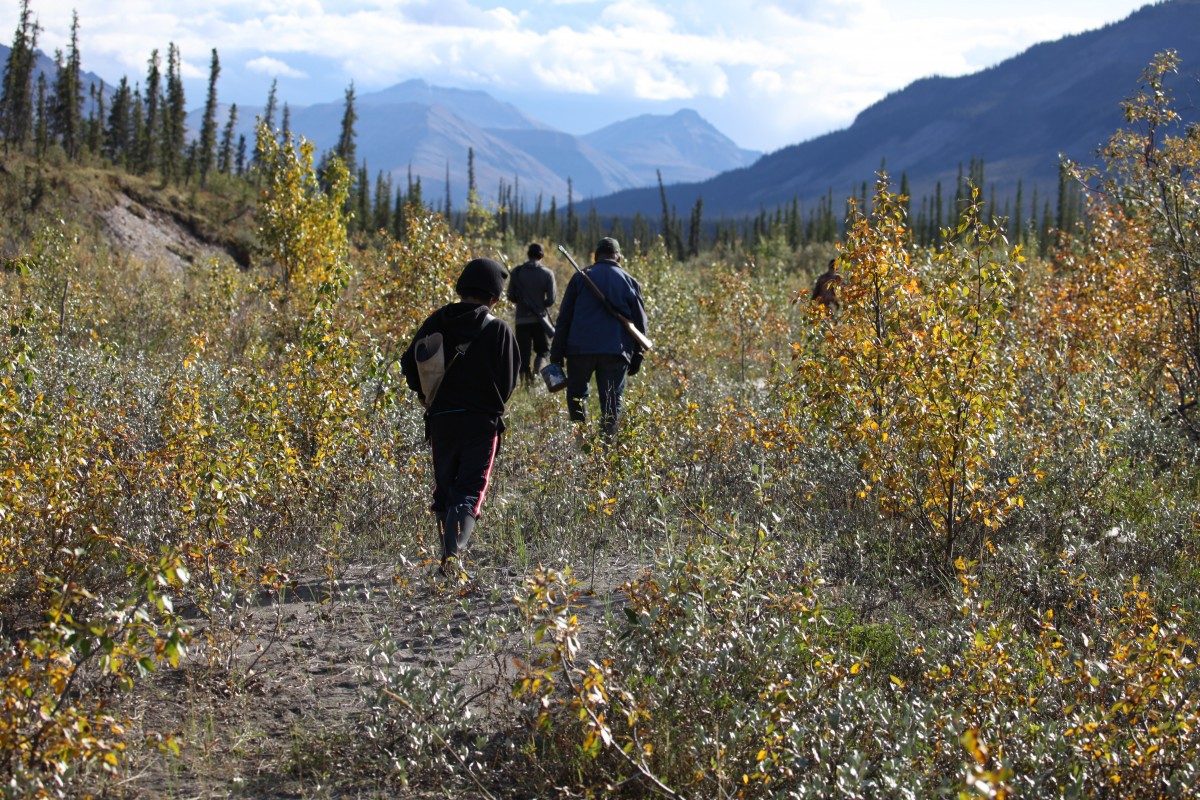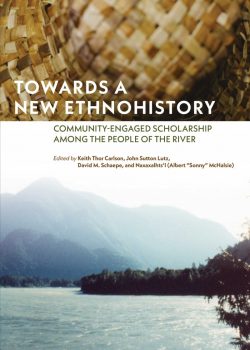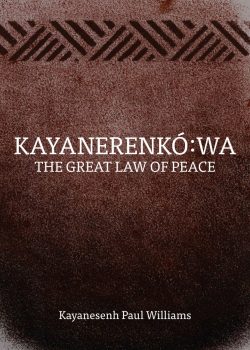
Members of Begade Shutagot’ine, a small community of a few hundred people living in and around Tulita (formerly Fort Norman), on the Mackenzie River in the Northwest Territories, have their story documented by Native Studies professor Peter Kulchyski in his book, A Report of an Inquiry into an Injustice. The Begade Shutagot’ine are the continued owners of the land and Kulchyski bears eloquent witness to the Begade Shutagot’ine people’s two-decade struggle for land rights, which have been ignored by federal and territorial authorities. // Image: UM Press
Top 5 2018 University of Manitoba Press Books
U of M Press picks some of its favourite titles from 2018
We published so many books we were proud of in 2018. We helped to re-map a ‘lost’ Métis community on Winnipeg’s southwestern edge and printed a manifesto on the ways the medical system fails Indigenous peoples.
We travelled with authors to Dene territory in the North West Territories to talk about land claims and to experience something of what it means to live on the land. We visited Stó:lō communities in BC to co-create a new decolonized approach to history.
Our authors looked at the Kanehsatake Resistance through the lens of literary criticism and type 2 diabetes in Indigenous youth in a history of medicine.
As the year draws to a close, we’re also looking ahead to spring 2019 titles—including the memoir of an Innu elder and a social justice-tinged history of the Jewish community in Winnipeg—but we thought we’d offer a few highlights from a busy yet fulfilling year in publishing. And, as a bonus, if you leave a comment on this story, you will be entered to win one of these book’s of your choosing. Two winners will be selected at random by U of M Press by Dec. 21, 2018.
Kayanerenkó:wa: The Great Law of Peace by Kayanesenh Paul Williams
Several centuries ago, the five nations that would become the Haudenosaunee—Mohawk, Oneida, Onondaga, Cayuga, and Seneca—were locked in generations-long cycles of bloodshed. When they established Kayanerenkó:wa, the Great Law of Peace, they not only resolved intractable conflicts, but also shaped a system of law and government that would maintain peace for generations to come. This law remains in place today in Haudenosaunee communities: an Indigenous legal system, distinctive, complex, and principled. It is not only a survivor, but a viable alternative to Euro-American systems of law. With its emphasis on lasting relationships, respect for the natural world, building consensus, and on making and maintaining peace, it stands in contrast to legal systems based on property, resource exploitation, and majority rule.
In Kayanerenkó:wa: The Great Law of Peace, Kayanesenh Paul Williams, counsel to Indigenous nations for forty years, with a law practice based in the Grand River Territory of the Six Nations, brings the sum of his experience and expertise to this analysis of Kayanerenkó:wa as a living, principled legal system. In doing so, he puts a powerful tool in the hands of Indigenous and settler communities.
- Recommended readers: Law students and legal scholars. People working in the legal system—laywers and judges. People inside and out of Haudenosaunee communities. People interested in Ontario history. People interested in Six Nations history or transnational history.
Report of an Inquiry into an Injustice: Begade Shutagot’ine and the Sahtu Treaty by Peter Kulchyski
 A Report of an Inquiry into an Injustice chronicles Peter Kulchyski’s experiences with the Begade Shutagot’ine, a small community of a few hundred people living in and around Tulita (formerly Fort Norman), on the Mackenzie River in the heart of Canada’s Northwest Territories. Despite their formal objections and boycott of the agreement, the band and their lands were included in the Sahtu Treaty, a modern comprehensive land claims agreement negotiated between the Government of Canada and the Sahtu Tribal Council, representing Dene and Métis peoples of the region. While both Treaty 11 (1921) and the Sahtu Treaty (1994) purport to extinguish Begade Shutagot’ine Aboriginal title, oral history and documented attempts to exclude themselves from treaty strongly challenge the validity of that extinguishment.
A Report of an Inquiry into an Injustice chronicles Peter Kulchyski’s experiences with the Begade Shutagot’ine, a small community of a few hundred people living in and around Tulita (formerly Fort Norman), on the Mackenzie River in the heart of Canada’s Northwest Territories. Despite their formal objections and boycott of the agreement, the band and their lands were included in the Sahtu Treaty, a modern comprehensive land claims agreement negotiated between the Government of Canada and the Sahtu Tribal Council, representing Dene and Métis peoples of the region. While both Treaty 11 (1921) and the Sahtu Treaty (1994) purport to extinguish Begade Shutagot’ine Aboriginal title, oral history and documented attempts to exclude themselves from treaty strongly challenge the validity of that extinguishment.
Structured as a series of briefs to an inquiry into the Begade Shutagot’ine’s claim, this book documents the negotiation and implementation of the Sahtu Treaty and amasses evidence of historical and continued presence and land use to make eminently clear that the Begade Shutagot’ine are the continued owners of the land by law: they have not extinguished title to their traditional territories; they continue to exercise their customs, practices, and traditions on those territories; and they have a fundamental right to be consulted on, and refuse or be compensated for, development projects on those territories. Kulchyski bears eloquent witness to the Begade Shutagot’ine people’s two-decade struggle for land rights, which have been blatantly ignored by federal and territorial authorities for too long.
- Recommended readers: Social justice warriors. Poets. Indigenous Studies students. Dene people. People interested in traditional life in the North. Activists. People travelling to the NWT in 2019.
Rooster Town: The History of an Urban Métis Community, 1901–1961 by Evelyn Peters, Matthew Stock, and Adrian Werner
 Rooster Town was a Métis community of on the outskirts of southwest Winnipeg that endured from 1901 to 1961.
Rooster Town was a Métis community of on the outskirts of southwest Winnipeg that endured from 1901 to 1961.
Those years in Winnipeg were characterized by the twin pressures of depression and inflation, chronic housing shortages, and a spotty social support network. At the city’s edge, Rooster Town grew without city services as rural Métis arrived to participate in the urban economy and build their own houses while keeping Métis culture and community as a central part of their lives.
In other growing settler cities, the Indigenous experience was largely characterized by removal and confinement. But the continuing presence of Métis living and working in the city, and the establishment of Rooster Town itself, made the Winnipeg experience unique.
Rooster Town documents the story of a community rooted in kinship, culture, and historical circumstance, whose residents existed unofficially in the cracks of municipal bureaucracy, while navigating the legacy of settler colonialism and the demands of modernity and urbanization.
- Recommended readers: Winnipeggers. Métis people. Descendants of people who lived in Rooster Town. Anyone who’s ever gone to Grant Park Mall, Pan Am Pool, or Grant Park High School. Mapmakers, aspiring GIS analysts, and data miners. Indigenous studies students and faculty.
Structures of Indifference: An Indigenous Life and Death in a Canadian City by Mary Jane Logan McCallum and Adele Perry.
 Structures of Indifference examines an Indigenous life and death in a Canadian city and what it reveals about the ongoing history of colonialism. At the heart of this story is a thirty-four-hour period in September 2008. During that day and half Brian Sinclair, a middle-aged, non-Status Anishinaabeg resident of Manitoba’s capital city, arrived in the emergency room of the Health Sciences Centre, Winnipeg’s major downtown hospital, was left untreated and unattended to, and ultimately died from an easily treatable infection. His death reflects a particular structure of indifference born of and maintained by colonialism.
Structures of Indifference examines an Indigenous life and death in a Canadian city and what it reveals about the ongoing history of colonialism. At the heart of this story is a thirty-four-hour period in September 2008. During that day and half Brian Sinclair, a middle-aged, non-Status Anishinaabeg resident of Manitoba’s capital city, arrived in the emergency room of the Health Sciences Centre, Winnipeg’s major downtown hospital, was left untreated and unattended to, and ultimately died from an easily treatable infection. His death reflects a particular structure of indifference born of and maintained by colonialism.
McCallum and Perry present the ways in which Sinclair, once erased and ignored, came to represent diffuse, yet singular and largely dehumanized ideas about Indigenous people, modernity, and decline in cities. This story tells us about ordinary indigeneity in the city of Winnipeg through Sinclair’s experience and restores the complex humanity denied him in his interactions with Canadian health and legal systems, both before and after his death.
Structures of Indifference completes the story left untold by the inquiry into Sinclair’s death, the 2014 report of which omitted any consideration of underlying factors, including racism and systemic discrimination.
- Recommended readers: Winnipeggers. Healthcare professionals—nurses, doctors, administrators. Urban Indigenous people. Policy analysts.
Towards a New Ethnohistory: Community Engaged Scholarship among the People of the River by Keith Thor Carlson, John Sutton Lutz, David M. Schaepe, Naxaxalhts’i – Albert “Sonny” McHalsie
 Towards a New Ethnohistory engages respectfully in cross-cultural dialogue and interdisciplinary methods to co-create with Indigenous people a new, decolonized ethnohistory. This new ethnohistory reflects Indigenous ways of knowing and is a direct response to critiques of scholars who have for too long foisted their own research agendas onto Indigenous communities. Community-engaged scholarship invites members of the Indigenous community themselves to identify the research questions, host the researchers while they conduct the research, and participate meaningfully in the analysis of the researchers’ findings.
Towards a New Ethnohistory engages respectfully in cross-cultural dialogue and interdisciplinary methods to co-create with Indigenous people a new, decolonized ethnohistory. This new ethnohistory reflects Indigenous ways of knowing and is a direct response to critiques of scholars who have for too long foisted their own research agendas onto Indigenous communities. Community-engaged scholarship invites members of the Indigenous community themselves to identify the research questions, host the researchers while they conduct the research, and participate meaningfully in the analysis of the researchers’ findings.
The historical research topics chosen by the Stó:lō community leaders and knowledge keepers for the contributors to this collection range from the intimate and personal, to the broad and collective. But what principally distinguishes the analyses is the way settler colonialism is positioned as something that unfolds in sometimes unexpected ways within Stó:lō history, as opposed to the other way around.
This collection presents the best work to come out of the world’s only graduate-level humanities-based ethnohistory fieldschool. The blending of methodologies and approaches from the humanities and social sciences is a model of twenty-first century interdisciplinarity.
- Recommended readers: Anyone doing research on/with Indigenous communities. Stó:lō people. People interested in BC history. People interested in decolonizing universities.








As an urban history and as the history of a community, Rooster Town is great reading.
These all look very interesting! I’m glad the U of M is committed to sharing these Indigenous histories.
I’ve lived in Manitoba since 1973, but I’d only heard of Rooster Town in the past year or so. All these books sound like they’d be fascinating reading. Kudos to the authors and to UM Press.
All look to be a very interesting read!
Looks like lots of great content coming out of the University of Manitoba Press!
I sort of knew UM Press existed but after reading the article I visited their website and was surprised at the scope of the publications. Not to mention the awards… well done!
Exciting Times at the University of Manitoba Press! Congrats to everyone published this year!
I actually requested that my library acquire each of these! They all sound so very interesting.
The world is in desperate need of a greater understanding of history and a path forward that moves us closer to justice, compassion and cooperation. I find the description of the book, Kayanerenkó:wa, the Great Law of Peace, fascinating and am looking forward to reading it.
This is an impressive list. Congratulations to the University of Manitoba Press for publishing such important work.